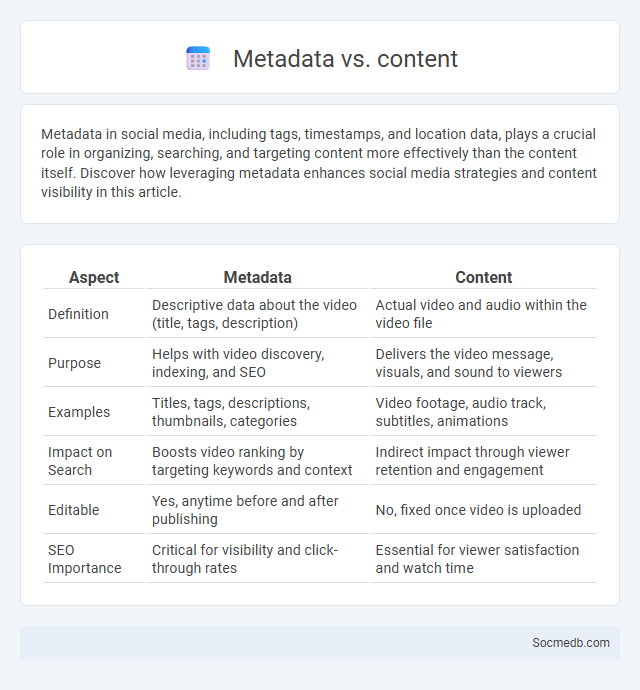
Photo illustration: metadata vs content
Metadata in social media, including tags, timestamps, and location data, plays a crucial role in organizing, searching, and targeting content more effectively than the content itself. Discover how leveraging metadata enhances social media strategies and content visibility in this article.
Table of Comparison
| Aspect | Metadata | Content |
|---|---|---|
| Definition | Descriptive data about the video (title, tags, description) | Actual video and audio within the video file |
| Purpose | Helps with video discovery, indexing, and SEO | Delivers the video message, visuals, and sound to viewers |
| Examples | Titles, tags, descriptions, thumbnails, categories | Video footage, audio track, subtitles, animations |
| Impact on Search | Boosts video ranking by targeting keywords and context | Indirect impact through viewer retention and engagement |
| Editable | Yes, anytime before and after publishing | No, fixed once video is uploaded |
| SEO Importance | Critical for visibility and click-through rates | Essential for viewer satisfaction and watch time |
Understanding Metadata: Definition and Importance
Metadata in social media refers to the underlying information that describes and gives context to your posts, such as timestamps, geolocation, device details, and user tags. Understanding metadata is crucial for optimizing content visibility, enhancing user engagement, and improving targeted advertising strategies. Leveraging this data effectively allows you to increase the reach and relevance of your social media presence.
Defining Content: What Sets It Apart?
Content on social media is defined by its ability to engage, inform, and entertain specific audiences through diverse formats like text, images, videos, and interactive elements. What sets social media content apart is its real-time nature, personalization, and the potential for rapid sharing, which drives community building and direct interaction with Your followers. Effective social media content leverages data analytics and trends to create relevant, targeted messages that resonate on a platform-specific level.
Metadata vs Content: Key Differences
Metadata provides essential information about your social media content, such as timestamps, location, tags, and author details, enabling better organization and searchability. Content refers to the actual text, images, videos, or posts shared, driving engagement and communication with your audience. Understanding the distinction between metadata and content enhances your strategy for optimizing visibility and user interaction across social platforms.
Types of Metadata: Structural, Descriptive, and Administrative
Social media platforms utilize three key types of metadata to enhance content organization and user experience: structural metadata, which defines the relationships and formatting within posts; descriptive metadata, providing detailed information like hashtags, captions, and keywords that improve searchability; and administrative metadata, managing content rights, privacy settings, and timestamps. Understanding how these metadata types function can help you optimize your social media presence by ensuring your content is correctly categorized and easily discoverable. Effective use of metadata supports better content management and targeted audience engagement on platforms like Instagram, Facebook, and Twitter.
The Role of Content in Digital Assets
Content serves as the cornerstone of digital assets on social media, driving engagement, brand visibility, and audience retention. High-quality, relevant content enhances algorithmic favorability across platforms like Instagram, Facebook, and TikTok, boosting organic reach and interaction rates. Effective content strategies leverage multimedia elements and targeted messaging to maximize the value and impact of digital assets in a competitive social media landscape.
Advantages of Leveraging Metadata
Leveraging metadata in social media enhances content discoverability by enabling precise filtering and targeted search results, improving user engagement. Metadata facilitates advanced analytics, allowing platforms and marketers to understand audience behavior and tailor content strategies effectively. Enhanced metadata usage also boosts content organization and recommendation algorithms, driving higher relevance and personalized user experiences.
Common Misconceptions: Metadata vs Content
Social media users often confuse metadata with content, assuming metadata like hashtags, timestamps, and geotags directly influence the message's meaning. Metadata serves as contextual or organizational data that enhances content discoverability, engagement analysis, and user targeting without altering the actual text or media. Understanding the distinction improves digital marketing strategies and helps optimize algorithmic visibility on platforms such as Instagram, Twitter, and Facebook.
Metadata in Search and Information Retrieval
Metadata in social media enhances search accuracy by providing structured data such as timestamps, geotags, hashtags, and user profiles that enable precise filtering and ranking of content. This enriched metadata supports advanced information retrieval techniques, improving relevance and speed in discovering user-generated content across platforms. Effective utilization of metadata attributes contributes to optimized indexing, resulting in improved visibility and user engagement in social media searches.
Best Practices for Managing Metadata and Content
Effective management of metadata and content on social media enhances discoverability and audience engagement by using clear, relevant tags, accurate descriptions, and consistent formatting. Structuring metadata with targeted keywords and maintaining updated information ensures your posts reach the right users while supporting SEO efforts. You should regularly audit and optimize content metadata to adapt to evolving platform algorithms and user behavior.
Future Trends: Evolution of Metadata and Content
Future trends in social media emphasize the evolution of metadata and content, transforming how platforms analyze and personalize user experiences. Enhanced metadata enables more accurate content categorization, improved search algorithms, and targeted advertising tailored specifically to your preferences. Integrating AI-driven content creation and dynamic metadata will redefine engagement, making social media interactions more intuitive and relevant.
 socmedb.com
socmedb.com